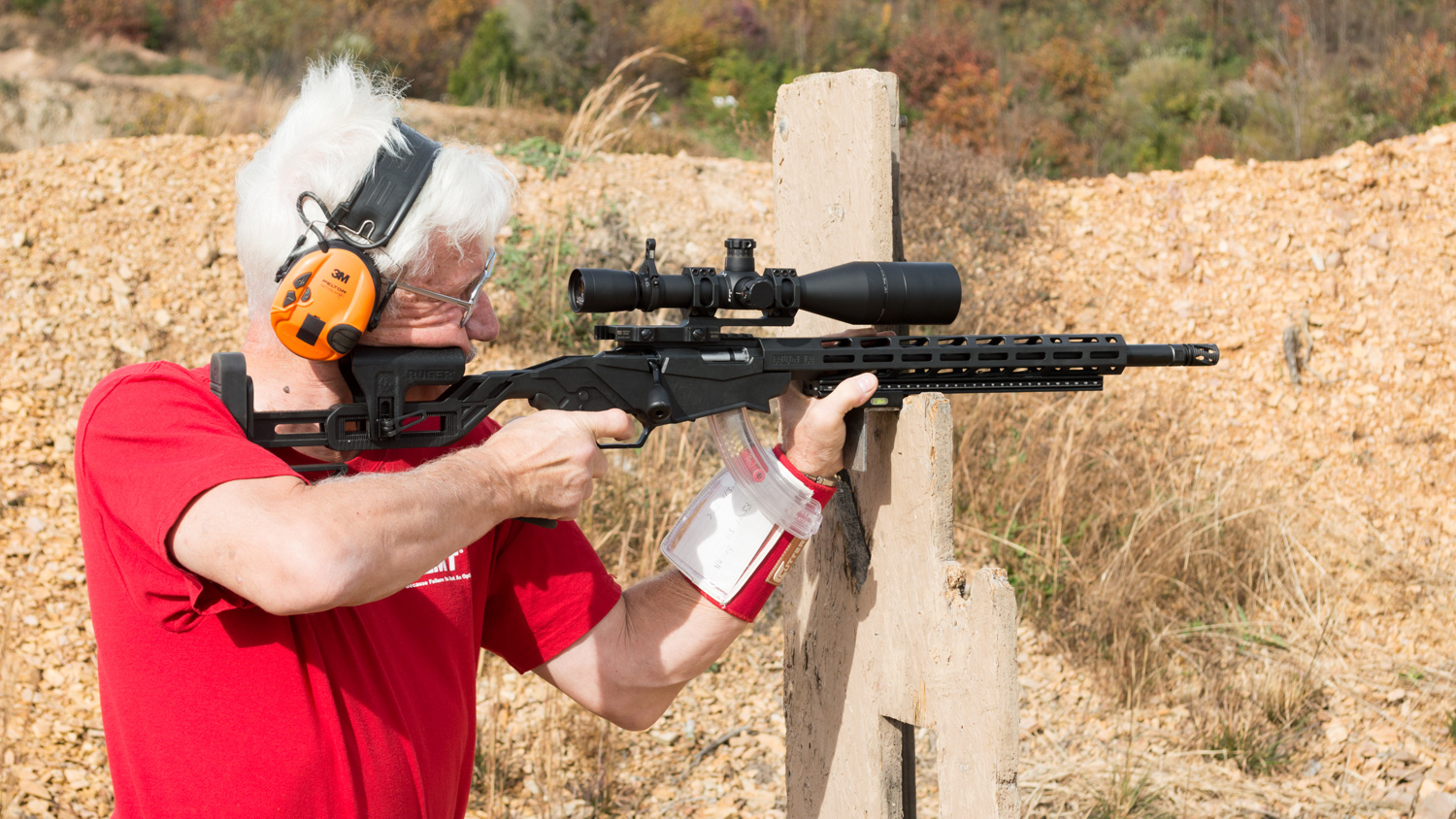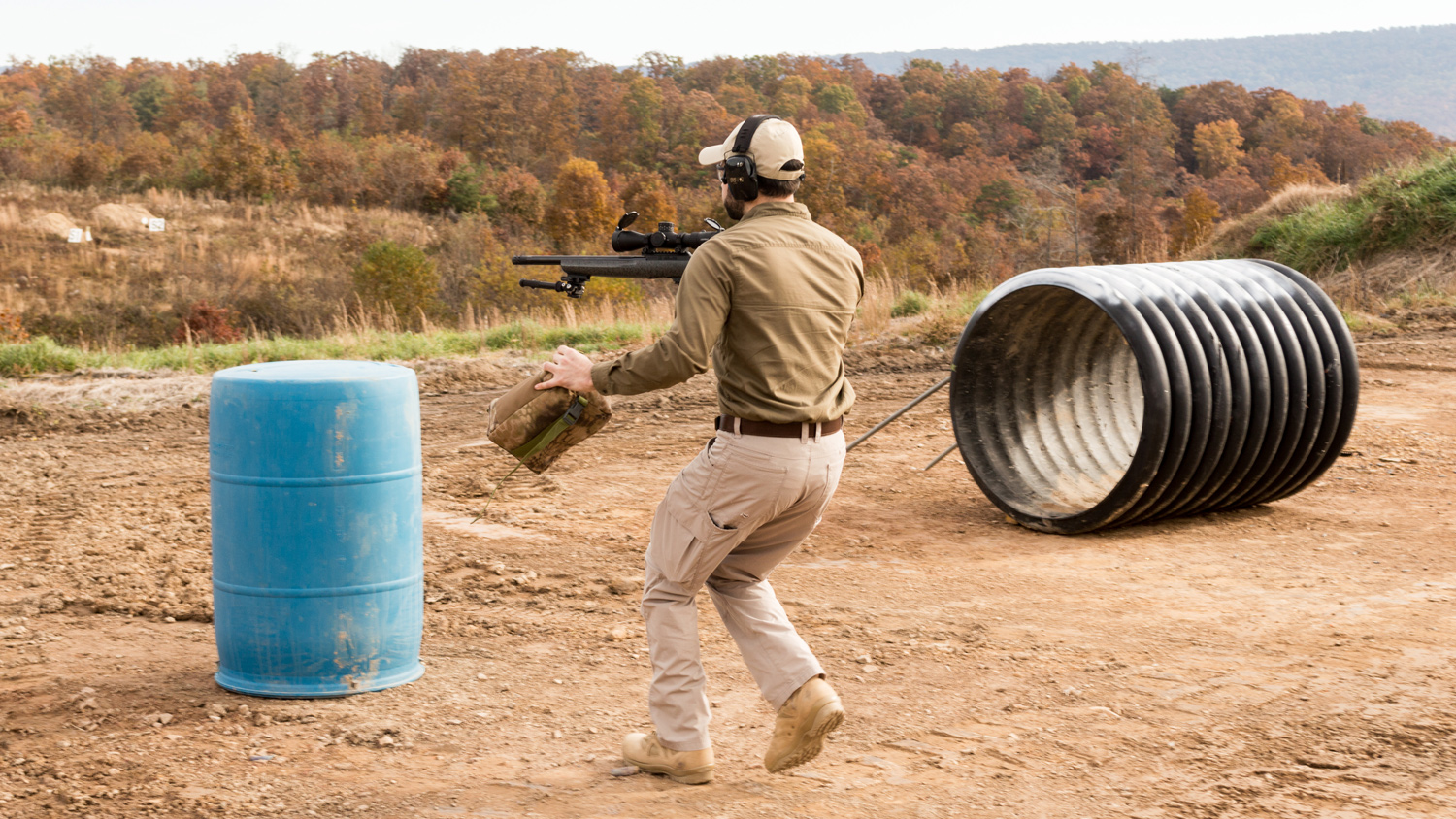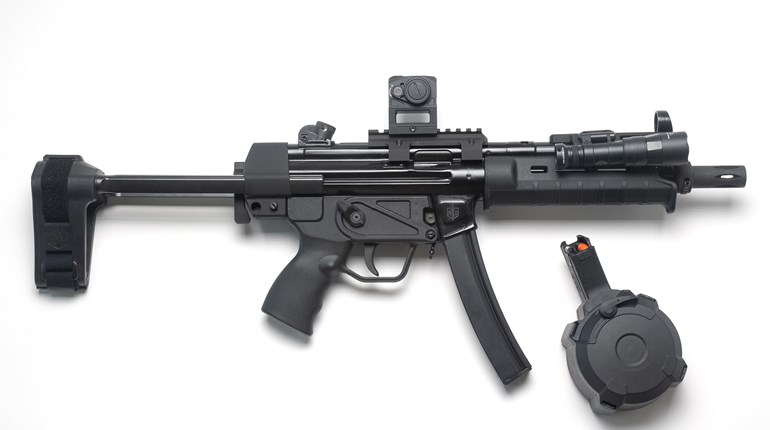
Above: Ruger’s Precision Rimfire rifle is ideal for high-level .22 LR competitions. Here, it’s equipped with the Leupold Mark 5HD 5-25x56mm scope and a Magpul bipod. All three are NRA Golden Bullseye winners.
Precision Rimfire competition offers the thrills of long-range shooting similar to PRS, but with the cost-effectiveness of rimfire ammo.

This is why over the last few years precision rimfire participation has exploded. Matches featuring the diminutive .22 LR cartridge blasted out well beyond 200 yards have become common. Increased interest in both the Practical Rimfire Challenge (PRC) and the National Rifle League rimfire division (NRL22) showcase this surge in the popularity of precision rimfire competition.
“The technology has finally caught up to what many competitive shooters want now—precision-level accuracy in a .22 LR cartridge,” says Cole McCulloch, director of NRA Competitive Shooting and a strong proponent of the precision-rimfire discipline. “Now, a .22 LR rifle can be used in competition out to 300 yards.”
What’s exciting here is the fact this is a pure precision-rifle shooting experience that is readily accessible to the masses. Using the relatively cheap and inexpensive .22 LR platform, add a decent scope and ammo, and anyone can excel in Precision Rimfire. You can build a good PRC setup for around $1,500. While some might balk at that price, this is practically a bargain considering the amount of money saved on ammunition.
Guns and ammo
Prices have gone down and quality is increasing across the board, including rimfire applications. Where the shooting sports have increasingly become more pay-to-play, precision rimfire offers a cheaper alternative.
You can get started in PRC or NRL22 shooting with a rifle that’s probably already in your closet.
A simple 10/22 rifle paired with a decent magnification optic will put you in good enough shape to place well in the PRC semi-automatic division—as long as it’s properly zeroed, you are feeding it good ammo and know your hardware well.

To quickly move up the food chain in precision rimfire, however, can require additional investment in specific areas.
“When people are building a PRC rifle, the important things like triggers, chassis, etc. are of course very important,” says McCulloch. “But, the ammunition and the glass are the most important of all.”
A good optic provides one big benefit: You can spot your impacts and easily dial for those long shots. For example, an optic like the Kahles K624i 6-24x56mm riflescope has a dense elevation turret, keeping things simple for dialing longer shots for stages with shooting distances that often vary hundreds of yards.

Jeremy Kisner, who shoots for Team Area 419, has been a precision-rimfire competitor for many years. He advises choosing an optic that offers plenty of travel on the first turret revolution.
“I can’t tell you how many times I’ve seen guys get lost in their turret rev’s when shooting rimfire targets, at distances near to extreme,” he points out.
The advantages of having superior optics become crystal clear to experienced PRC shooters that have a few matches under their belts.
“Once the rifle is shooting properly and the ammunition is going well, the ability to use great glass and spot the smallest impacts is very critical,” says McCulloch.

Spotting impacts without coming off the rifle are what transitions novices to experienced shooters in precision rimfire. Additionally, achieving success in this discipline requires the ability to read reticles effectively, adjust to adverse wind situations quickly and also understand external ballistics well enough to make decisions on the fly.
Regarding optics, quality glass is always important, no matter the sport. But don’t ignore reticle choice. Reticle choice is a highly personal thing. Having a reticle that allows you to quickly and easily make adjustments is essential to meeting your par times, and thus achieving a good hit factor. Pick one that you are comfortable with.

There’s also one final reality: In terms of reliability, the rimfire platform isn’t exactly the best. Especially semi-automatics. When on the clock, a shooter has to be ready to deal with the inevitable unexpected situations that can crop up; whether its fouling, jamming or some sort of malfunction. You must know your hardware inside and out to effectively deal with these kinds of problems at a match.
Practical Rimfire Challenge
This sport is so easy to get into that both completely new competitive shooters and old shooters alike are having fun competing at matches together.
Kisner notes how the sport provides shooters situations that are best described as unconventional if they aren’t familiar with PRS-style competition, such as engaging steel plates at long distance.
“We’ve been successfully hitting our marks under time constraints on appropriately-sized steel targets from 10 to 300 yards. Often, this shooting is not in comfortably-prone positions,” he says about the sport.
With shooting distances as far as 300 yards, PRC matches are much more than just a rimfire version of Precision Rifle Series (PRS) competition. (PRS has emerged as the fan favorite with the precision centerfire long-range crowd nationwide.)
The sport has definite PRS origins, but hardware differences alone necessitate different approaches to equipment, rules and stage design.

Compared to centerfire, the rimfire round is getting pushed around a lot more once it leaves the barrel. This sport takes all the rigors and challenges that a precision centerfire rifle cartridge faces, only cramming those same conditions to a much smaller playing field. There isn’t as much breathing room. And that’s one reason it’s so much fun to shoot.
“People think that PRC is a little version of PRS. It’s not,” explains McCulloch. “It’s similar in terms of shooting style, but the way a centerfire rifle shoots and a precision rimfire rifle shoots is different. The recoil is not there. For example, recoil is the reason why the 6mm and 6.5mm Creedmoor cartridges rule the sport of PRS.”
Rifles can be either bolt-action or semi-automatic. Advanced long-range rimfire shooters often make the jump to a bolt-action after they’ve pinnacled with a semi-automatic.
Each stage of a PRC competition presents a different shooting scenario that utilizes multiple shooting positions and equipment. These matches usually have nine stages. Targets utilized are different combinations of steel and reactive targets.

Although single-shot rifles are allowed, they can put shooters at a disadvantage. This is not a benchrest or prone type of match—shooters encounter movement and are expected to use improvised positions.
Scores from PRC events conducted over the season are accumulated into a points series. The 2018 Lapua Practical Rimfire Challenge season finale featured nine stages, with competitors tackling distances of up to 295 yards.

Position plays a large role in successfully shooting a PRC-style stage. Shooters ask the questions: How do you orient yourself in such a way so that everything is locked onto something else? How do I gain the most advantages stability-wise with whatever stage features are at my disposal? Essentially, this part is the wildcard of the sport. Everyone shoots and approaches stages differently. Gear matters, but you have to know how to use it first.
“Like any sport, specific props, targets, etc. are what will make any match difficult to conduct,” says McCulloch. “Practical Rimfire Competition is bit of a space race at this point at the highest echelons.”

In the end, precision rimfire is a cheaper and more affordable way for people to enjoy competitive shooting. Although it is a young sport that is still developing, it has enormous potential, and is continuing to evolve.
“It’s amazing how far we have come,” concludes McCulloch. “With a decent .22 LR rifle, good ammo and scope you can be competitive at 300 yards.”
Learn more about Precision Rimfire:
- Lapua Practical Rimfire Challenge (100-300+ yards).
- National Rifle League .22 LR (up to 100 yards).

































